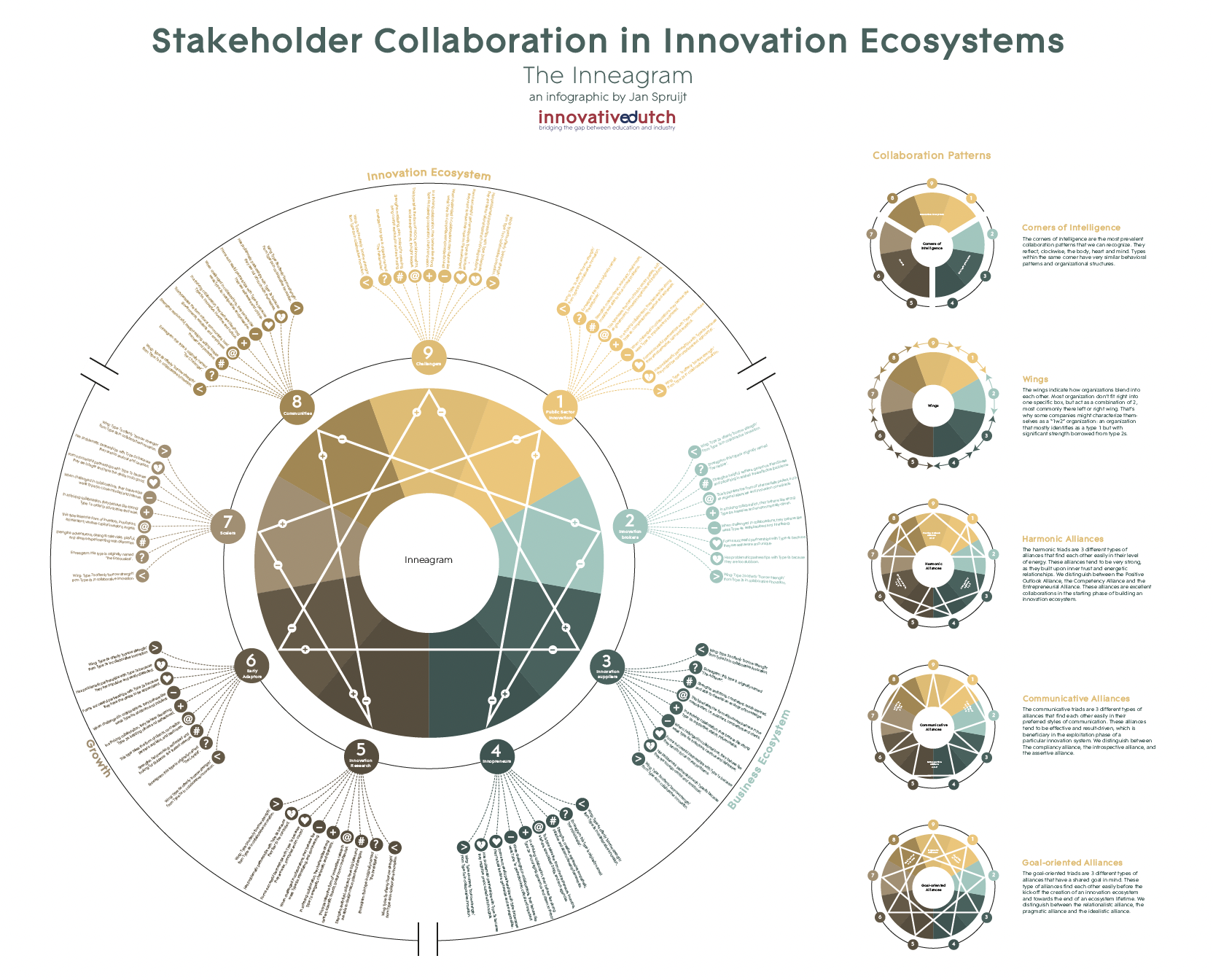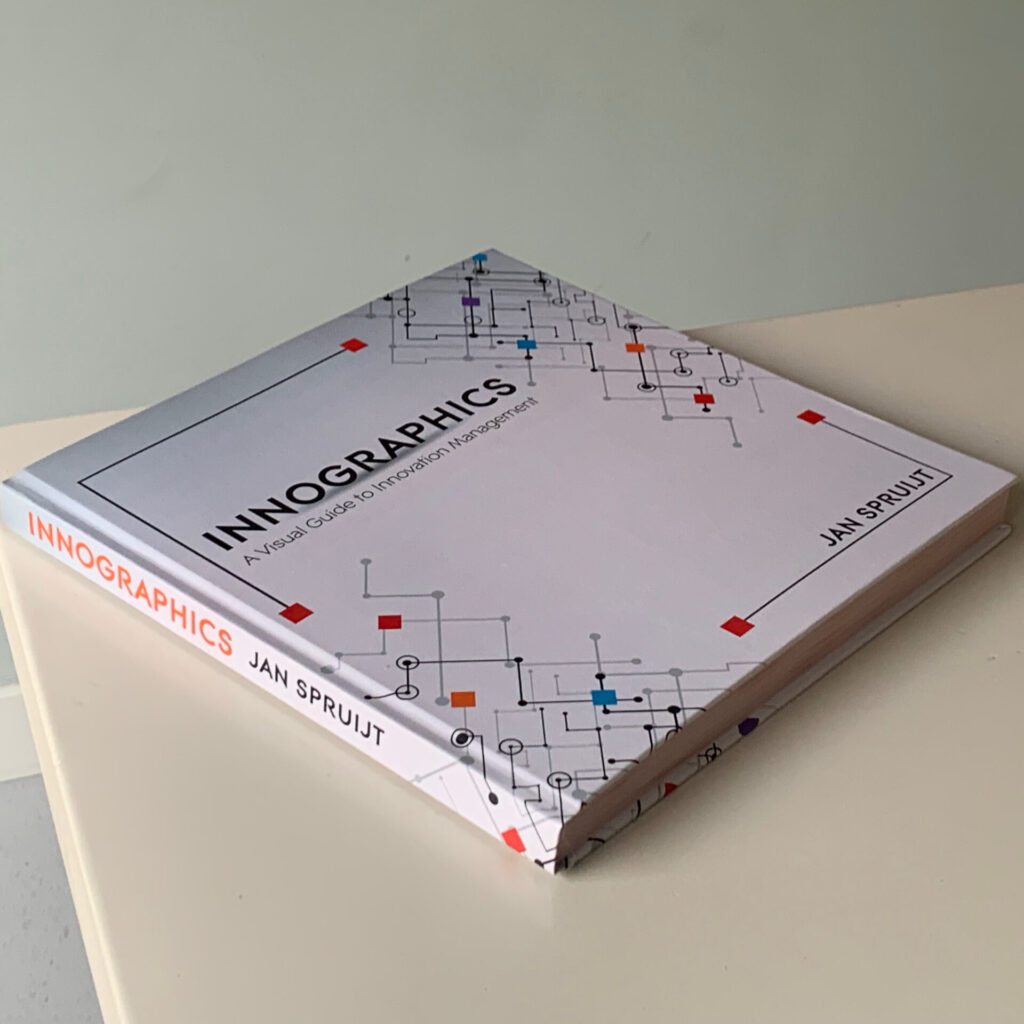The story of this infographic began 16 years ago during a Summer School organized by the University of Cambridge. Not in the City of Perspiring Dreams itself, but on the mystical mountain Uludağ in Turkey, with 15 fellow students in a mountain hut more than 1 hour away from the nearest town with cellphone reception. On this mountain, led by Cambridge professor Jim Platts, we took an ESTIEM traineeship in transformative leadership. Without taking a deep dive into the material of the Summer School, one of the models that we started to work with was the Enneagram. Not only the power of the model itself, but also the history behind it, really intrigued me and so the story began.
Over the years, I’ve read much more about the Enneagram. Mostly used in (business) psychology, the framework is best described as an adaptive approach to recognize your own – and others’- behaviour in interactions with others. So it’s not, as many think, a framework for personality traits, like the Myers-Briggs Type Indicator (MBTI) or the Big-5 personality test. It perhaps holds the middle between these personality tests and the Rose of Leary, a theory of behavioral influence. The theory helps you to find your comfort-spot and from there on explains how your interactions with others happen and could be improved if you learn how to read it. It’s adaptable: it may change under different circumstances, under different preconditions and in different situations.
Inneagram
And there it is: these transformative processes are very prevalent in innovation ecosystems as well. When, for a research study I was doing, I finally created a list of 9 different stakeholders that are preconditional for successful innovation ecosystems, I got the idea of combining the enneagram (ennea = 9) and replace the types with ‘stakeholder types’. Obviously, this didn’t fit seamlessly and I started to research relationships in collaborative innovation to optimize this framework – and the inneagram was born.

This infographic is part of the book Innographics: A Visual Guide to Innovation Management
Download a 32-page preview for free
Including 2 infographics, 2 chapters and an overview of 28 innographics.
☑ I agree with opting in for the newsletter, our terms and privacy policy.

9 Types of Stakeholders
In the framework, I’ve distinguished between 9 types of stakeholders:
- Public Sector Innovation: This type takes the form of public sector parties, such as government, innovation agencies and institutions.
- Innovation Brokers: This type takes the form of intermediate parties, such as regional agencies and innovation consultants.
- Innovation Suppliers: This type takes the form all business partners in the mesosystem, i.e. suppliers, competitors and clients.
- Innopreneurs: This type takes the form of entrepreneurs, inventors, startups, specialized SMEs, and tech agencies.
- Innovation Research: This type takes the form of universities, research centers, scientific boards, boardroom consultancies.
- Early Adaptors: This type takes the form of clients, co-creation partners and labs, and lead users.
- Scalers: This type takes the form of investors, incubators, accelerators, venture capital investors, angels.
- Communities: This type takes the form of local communities, local governments, residents and employees.
- Challengers: This type takes the form of NGO’s, social innovators, social entrepreneurs, thought leader
For each of the stakeholders, the Inneagram identifies the following:
< Left wing: from which type does this type lend its strengths from when collaborating?
? The original name in the enneagram
# Its strengths in collaborative innovation alliances.
@ Typical parties associated with this type.
+ How these types behave in thriving collaborations
– How these types might behave when challenged in collaborations.
? Which type this type usually forms very strong bonds with.
? Which type this type usually forms very problematic alliances with.
> Right wing: from which type does this type lend its strengths from when collaborating?
How to use
There are several ways to use the Inneagram. The most common ones are:
- Corners of Intelligence: The corners of intelligence are the most prevalent collaboration patterns that we can recognize. They reflect, clockwise, the body, heart and mind. Types within the same corner have very similar behavioral patterns and organizational structures.
- Wings: The wings indicate how organizations blend into each other. Most organization don’t fit right into one specific box, but act as a combination of 2, most commonly there left or right wing. That’s why some companies might characterize themselves as a “1w2” organization: an organization that mostly identifies as a type 1 but with significant strength borrowed from type 2s.
- Harmonic Alliances: The harmonic triads are 3 different types of alliances that find each other easily in their level of energy. These alliances tend to be very strong, as they built upon inner trust and energetic relationships. We distinguish between the Positive Outlook Alliance, the Competency Alliance and the Entrepreneurial Alliance. These alliances are excellent collaborations in the starting phase of building an innovation ecosystem.
- Communicative Alliances: The communicative triads are 3 different types of alliances that find each other easily in their preferred styles of communication. These alliances tend to be effective and result-driven, which is beneficiary in the exploitation phase of a particular innovation system. We distinguish between The compliancy alliance, the introspective alliance, and the assertive alliance.
- Goal-oriented Alliances: The goal-oriented triads are 3 different types of alliances that have a shared goal in mind. These type of alliances find each other easily before the kick-off the creation of an innovation ecosystem and towards the end of an ecosystem lifetime. We distinguish between the relationalistic alliance, the pragmatic alliance and the idealistic alliance.
The Inneagram is now available as a download in our Innovation Toolbox and I’d be happy to answer any questions you might have!
Great infographic – I want the high-res PDF .
Good morning.
Unfortunately the download link does not work .
the Inneagram: Stakeholder Collaboration in Innovation Ecosystems
Hi Dario,
It works, but brings you to the purchase page of the Innovation Toolbox. However, through my LinkedIn Profile, as a way of promotion, I’m offering the infographic for free this week.
Best wishes,
Jan
Hi Jan, the Innovation Inneagram artefact looks great. Please DM me a copy. Regards, Brett Peppler
Hu Brett, you can buy it as part of our Innovation Toolbox (and only this week as a promotion through LinkedIn). Jan
Dear Jan,
Great infographic! When I click on the download link and enter my email I receive the link to a very different graphic and not for the »inneagram«. Can you assist me with this.
Thank you in advance.
Best regards,
Judith
The infographic is for sale as part of the Innovation Toolbox. You can only download a sample, which is not this infographic. I’m offering the infographic for free only this week, as a promotion, on LinkedIn.
Hi Jan
I have been following your work and infographs for several years now.
It keeps getting better and the attention to detail is exceptional.
Congratulations with the latest infograph.
Thanks Louis!
Wings
The wings indicate how organizations blend into each other. Most organization don’t fit right into one specific box… I would say most organizations don’t fit ….
9: Challengers
Has problematic partnerships with Type 2s because they are take a rational apporach in finding solutions. I would say because they take…. and then a rational approach…
7: Scalers: This type takes the form of investors, incubators, accelerators, venture capital investors, angels. Not sure if angels fit the description of scalers, unless I am missing something here…
Hope that helps!